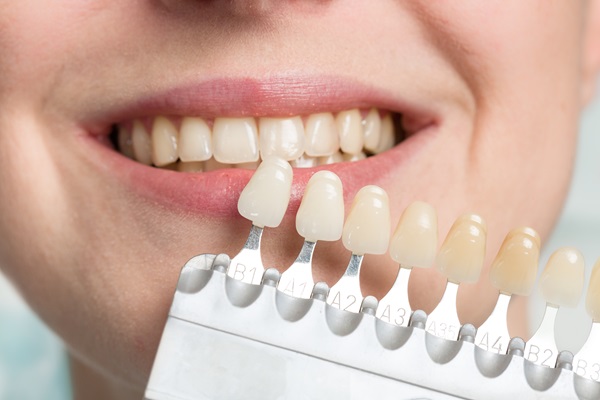Understanding Composite Versus Porcelain Veneers

Treatments available to improve minor aesthetic issues with your teeth include dental veneers that cover up such imperfections to give your teeth a more uniform appearance. There are two separate treatments that are referred to as veneers, and while they accomplish the same purpose, they have little in common with one another otherwise.
How are composite and porcelain veneers different?
Knowing the difference between porcelain and composite dental veneers can help you determine which treatment option is more appropriate for you.
Material
Composite veneers are so called because they consist of several different materials blended together. The main component is an acrylic resin, which is a type of plastic. This is combined with particles of a material such as silica or quartz for reinforcement. Porcelain veneers are made of a ceramic material.
Application
Composite veneers are applied by painting the liquid resin onto the tooth, sculpting it, and then curing it with a special light to harden it once it has reached the desired shape. The tooth requires very little prep work beforehand.
Porcelain veneers consist of thin shells, each of which fits over an individual tooth. Before veneers can be placed, the teeth have to be prepared by removing small amounts of enamel from each tooth. There is a wait of a few weeks before porcelain veneers can be placed because they have to be custom-made for you in a laboratory.
Customizability
Both composite and porcelain veneers are customizable, but in different ways. Porcelain veneers are made for you in a lab according to specifications provided by your dentist. Composite veneers can be sculpted into the desired shape before curing, and possibly modified afterward.
Appearance
Like natural teeth, porcelain veneers are smooth and slightly translucent, giving them a more natural appearance. Composite veneers are more opaque but can be sanded down to give them the smoothness of a natural tooth.
Strength
Both composite and porcelain veneers can become damaged over time and require replacement. Composite veneers wear out in about five to seven years while porcelain veneers typically last 10 to 20 years.
Versatility
There are some situations in which composite veneers do not work well. Because they are painted onto the tooth, they are not able to close severe gaps between the teeth. If the tooth is deeply discolored, the composite material may not be sufficient to cover it up. Porcelain veneers are able to address issues such as these where composite would not be appropriate.
Treatment time
You have to wait for porcelain veneers to come back from the lab before they can be applied. There are no such delays for composite veneers, which are a same-day treatment.
Reversibility
If you change your mind about composite veneers later, you can easily have them removed. The lack of preparation required prior to application makes it possible to reverse them. Porcelain veneers are considered permanent because they require the removal of some tooth enamel, albeit very small amounts. They can be removed by a dentist but have to be replaced with new veneers.
Which veneer option is right for you?
Each choice is quite different so it is important to determine which one would be the most appropriate for your unique situation. In both scenarios, the affected tooth must be healthy overall. A tooth that is severely decayed, damaged, or does not have a healthy root intact should not and cannot be effectively treated with either type of veneer. In these situations, other options should be explored, such as crowns, bridges, implants, or partial dentures.
Composite veneers work well for people who have mostly cosmetic tooth issues. This includes discolorations that will not respond to whitening treatments and very minor chips or cracks. They can be a good option for people who need a less invasive treatment procedure and are willing to have it redone every few years.
Porcelain veneers can address all of the same issues composite veneers can. However, they are a more appropriate treatment option for more significant tooth damage. In addition, veneers are a good option for people who have unevenly sized, shaped, or spaced teeth. Patients may prefer veneers if they want a longer-lasting treatment option.
Conclusion
Though different from one another, composite and porcelain dental veneers are both effective treatments for improving the appearance of minor flaws in teeth. To choose the right option and develop a proper treatment plan, talk with a dentist about your concerns and goals.
Request an appointment here: https://www.johnscreekteeth.com or call Johns Creek Dentistry at (770) 623-1427 for an appointment in our Johns Creek office.
Check out what others are saying about our dental services on Yelp: Dental Veneers in Johns Creek, GA.
Recent Posts
You can cover up imperfections in your teeth with dental veneers, thin shells of porcelain that fit over your teeth, and bond to them. Veneers can last for at least a decade, but they typically need to be replaced occasionally if a dentist must treat underlying tooth decay or gum disease. Veneers can also stain;…
If you are wanting a smile makeover, veneers are an affordable and effective option. As a restorative solution, dental veneers are custom-made shells bonded to the front of your teeth. They are made of thin composite resin or porcelain and attached with dental cement. The veneers share the same color as the natural tooth, but…
As more patients seek cosmetic dental treatment, dental veneers are more popular than ever. These restorations can completely transform a patient's smile. A porcelain or composite veneer can change a tooth's size, shape, or color. It can also be used to repair mild to moderate damage in some situations. This can help protect a person's…
For those who suffer from damaged teeth, veneers can offer a natural-looking, long-lasting option to restore a beautiful and healthy smile. However, patients with these dental restorations should take extra care to protect them. Some dietary changes may be necessary for complete care.Most foods that are unhealthy for natural teeth are also unhealthy for veneers.…


